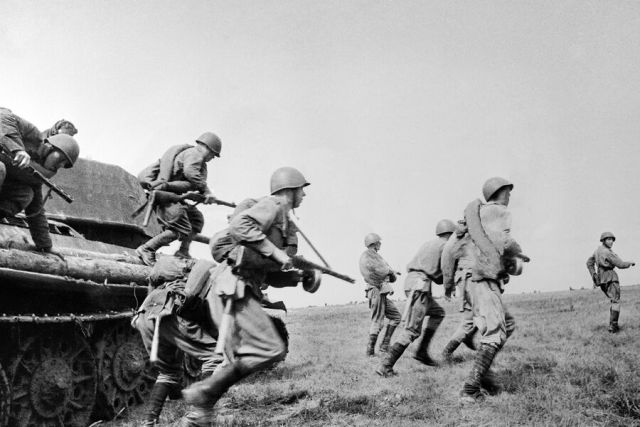Colonel Khodarenok described how the Wehrmacht tanks were unable to change the course of the Battle of Kursk
80 years ago - on August 23, 1943 - the Battle of Kursk ended with the liberation of Kharkov. In terms of the number of troops, forces and means involved, it surpassed both the Battle of Moscow and the Battle of Stalingrad. About the confrontation between the armored forces of the Wehrmacht and the Red Army and why the newest German tanks "Tiger" and "Panther" did not help Germany to win - in the material of the military observer "Gazeta.Ru" by Mikhail Khodarenka.
One of the greatest battles of the Second World War - the Battle of Kursk - lasted 50 days. The Wehrmacht suffered a defeat in it, from which it could not recover until the end of the war. The Air Force of the Workers' and Peasants' Red Army (Red Army) won air supremacy and firmly held it until the end of the war. After Kursk, Germany finally abandoned strategic offensive operations and switched to defense on the entire Soviet-German front. The strategic initiative passed to the Red Army.
Three strategic operations were carried out during the Battle of Kursk: the Kursk Strategic Defensive Operation (July 5 - 23, 1943), the Orel Strategic Offensive operation (code name "Kutuzov", July 12 - August 18, 1943), the Belgorod-Kharkov Strategic offensive operation ("Rumyantsev", August 3 - 23, 1943). As a result of these operations, the Red Army drained and then stopped the offensive of the Wehrmacht strike groups, inflicted a major defeat on army group Center, stormed the city of Orel, defeated the enemy's Belgorod-Kharkov grouping, liberated Belgorod and Kharkov, and created favorable conditions for the liberation of Left-Bank Ukraine.
In the summer of 1942, the USSR made every effort to produce more T-34 medium tanks. At the same time, research and development work on the creation of advanced armored combat vehicles in the country was almost curtailed.
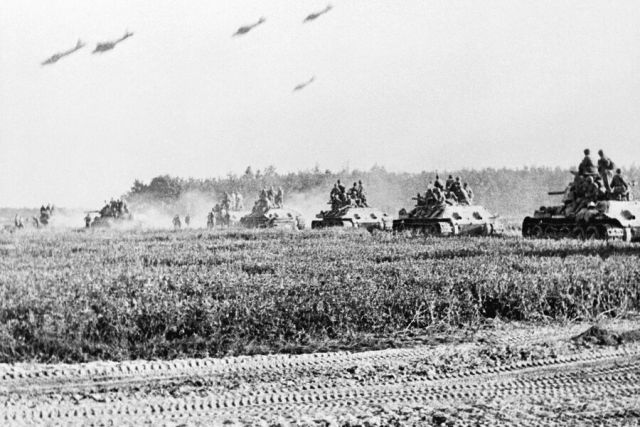
The counteroffensive of the Soviet troops on July 12, 1943
Image source: Mikhail Melnik/RIA Novosti
In Germany, at the same time, several promising tanks, self-propelled artillery units and assault guns were launched into a series, combat vehicles already consisting of Wehrmacht armored troops were significantly modernized. The latter should primarily include Pz.Kpfw IV. Ausf. F2 with a long-barreled 75 mm gun KwK 40 L/43 and Pz.Kpfw IV. Ausf. G and H with the KwK 40 L/48 cannon. The booking of the front part of the hull of the H variant increased to 80 mm, and this modification was already significantly superior to the T-34 tank in its TTX.
For the first time, Panther medium tanks (Pz.Kpfw V. Ausf. D) and Ferdinand heavy self-propelled artillery (8,8 cm StuK 43 Sfl L/71 Panzerjäger Tiger (P), Sturmkanone mit 8,8 cm StuK 43, Sd.Kfz.184). There were 90 Ferdinands in total on the Kursk Bulge (two battalions). For the first time, Tiger I heavy tanks (Pz.Kpfw.VI Ausf. E).
Self-propelled assault guns StuG III and StuG 42, self-propelled artillery installations Hornisse, Hummel, Wespe and some other vehicles were also noted in the battles near Kursk.
Powerful "Tigers"
The greatest interest among the newest German armored fighting vehicles, of course, is the heavy tank "Tiger I" (Pz.Kpfw.VI Ausf. E). In 1942, 78 Tiger I tanks were manufactured, in 1943 - 649 tanks, in 1944 - 623 tanks, that is, the Wehrmacht received 1,350 tanks in total.
Tiger I tanks had factory numbers from 250001 to 251350. Now only a few "live" tanks of this type have been preserved. There is a tank 250122 in the Bovington Museum of the United Kingdom, a tank 259912 in the museum of the city of Sisheim, another tank Pz.Kpfw.VI Ausf. E is located in the Museum of the History of Armored Vehicles of the Ministry of Defense of Russia in Kubinka.
At the time of its appearance and for some time, the Tiger was the most powerful tank in the world. His 88-mm KwK 36 L/56 cannon had no equal, and no projectile could penetrate the frontal armor. At a distance of 1.5-2 km, the Tiger confidently hit all types of Soviet tanks. In addition to the cannon, the Tiger was equipped with two 7.92 mm MG34 machine guns. The tank's ammunition was 92 shells and 4.5 thousand rounds.
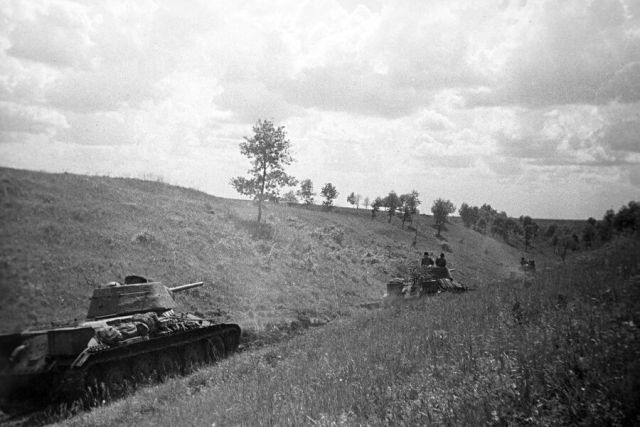
Tanks are going into reconnaissance. Belgorod direction, July 1943
Image source: Fedor Levshin/RIA Novosti
The tank body had a fairly simple outline and was made of rolled armor. The lack of angles of rational inclination of the armor was compensated by its thickness. The Tiger's armor protection looked like this:
body: forehead - 100 mm, side - 80 mm, stern - 80 mm, roof - 25 mm, bottom - 25 mm;
turret: forehead - 100 mm, side - 80 mm, cannon mask - 110 mm.
The Tiger would have been the first German tank with a chassis in which the support rollers were installed in a staggered order (the idea of engineer Knipkamp). This system with a torsion bar suspension ensured smooth running of the car and relative comfort of the crew. However, during the operation of tanks on the Eastern Front in winter, snow and mud were stuffed between the rollers, which froze overnight and by morning blocked the chassis of the Tiger.
There were also great difficulties with the repair of tanks in the field. In order to replace one or two damaged internal rollers, it was necessary to disassemble almost the entire suspension of the combat vehicle. The operation of the Tiger was significantly complicated by the presence of two types of tracks: transport tracks with a width of 520 mm, and combat tracks with a width of 725 mm. Such a technical solution was dictated by the fact that the tank's width did not fit into the dimensions of the Reich railways. Sometimes the external rollers were also removed during transportation. In short, when making marches by rail, the car had to be "re-shoed" several times.
Two types of engines were used in the production of the Tiger I tank: the Maybach HL210P30 petrol engine with a capacity of 650 hp was installed on the first 250 cars; on the remaining tanks, the Maybach HL230P45 with a capacity of 700 hp. Fuel consumption per 100 km reached very impressive values: 270 liters on the highway, along a dirt road - 480 liters. But this is only on the passport. In fact, there were significantly more. The combat weight of the tank reached 56 thousand kg .
Only two Tiger battalions took part in the Battle of Kursk. The 505th Heavy Tank Battalion (45 vehicles) operated as part of Army Group Center (northern face of the Kursk Bulge). On the southern face of the arc, the 503rd heavy tank battalion took part in the fighting (according to some sources - 43 vehicles, according to others - 45).
In addition, heavy tank companies of Tigers were in the combat composition of some elite motorized divisions - "Great Germany" (15 tanks), SS "Leibstandarte Adolf Hitler" (13), SS "Death's Head" (15) and SS "Reich" (14). In total, no more than 145 Tigers took part in the Kursk Bulge.
Invulnerable "Panthers"
Another German novelty from the time of the Kursk Bulge is the Panther medium tanks (Pz.Kpfw V. Ausf. D2). The enhanced engine and improved gearbox made it possible to raise the thickness of the frontal armor of this version of the Panther to 80 mm, which made it virtually invulnerable to all Soviet tank and anti-tank guns.
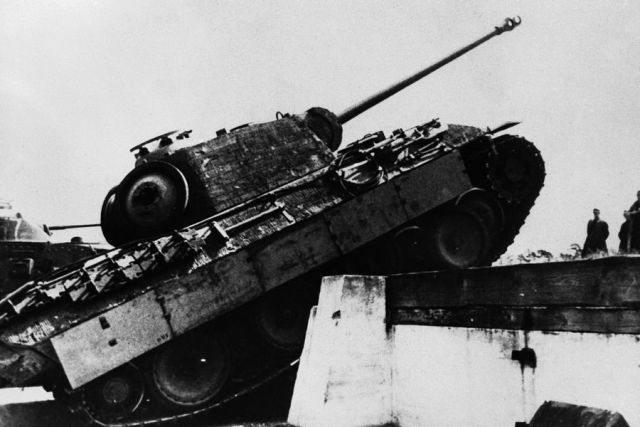
Panther Tank
Image Source: AP
Armament Pz.Kpfw V. Ausf. The D2 - 75mm KwK 42 L/70 cannon with a barrel length of 70 calibers was designed mainly to fight tanks. The armor penetration of the KwK 42 at a range of 2,300 m with a PzGr 40/42 projectile exceeded 100 mm. The frontal armor of the T-34, we recall, was only 45 mm.
The first new tanks were received by the 51st and 52nd tank battalions, which formed the core of the 10th Tank Brigade, which completed its formation by June 14, 1943 and took part in the fighting on the southern face of the Kursk Bulge. This brigade consisted of 200 "Panthers" (including four command vehicles).
However, in less than a week of fighting 127 "Panthers" were lost. A significant part has failed due to technical reasons. By July 12, 1943, only 41 vehicles of this type remained in service on the southern face of the arc.
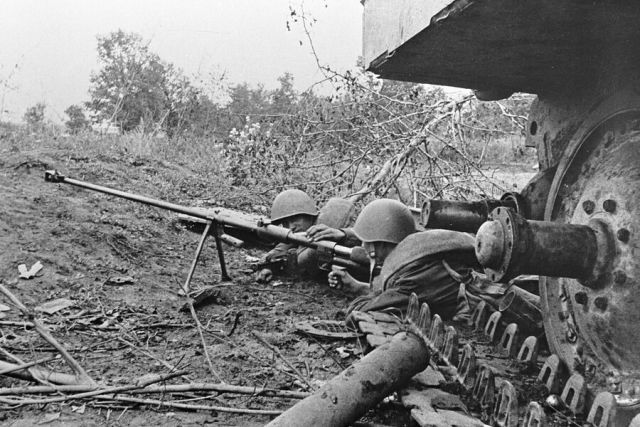
Armored guards reflect an enemy tank attack, lying next to a damaged tank, 1943
Image source: Yakov Ryumkin/RIA Novosti
Mines and guns against tanks
And before the Battle of Kursk, and according to the results of the fighting, People's Commissar of Defense Marshal of the Soviet Union Comrade. Stalin was presented with several memos. One of them (compiled at the end of June 1943), in particular, stated: "The artillery armament of the T-34 tanks and the KV-76-mm guns - have allowed up to now to conduct a successful fight against all enemy tanks. The appearance of the enemy tank T-VI (i.e. "Tiger I", aka Pz.Kpfw.VI Ausf. E), whose armor is not penetrated by the 76-mm F-34 cannon, destroyed this advantage. There was an urgent need to equip our tanks with larger caliber guns with better penetration capability."
Following the results of the fighting near Kursk, Stalin was presented with another memo, which noted: "in the battles on the Orel, Kursk, Belgorod and Kharkov directions, the enemy used new types of tanks and self-propelled artillery (Tiger, Panther, Ferdinand) with 75 and 88 mm caliber guns, having the greater initial velocity of the projectile (830-1050 m/sec) and the increased thickness of the reservation, designed to protect our 76-mm guns from being hit by an armor-piercing projectile from all distances ...".
Only under favorable tactical conditions, which developed exclusively during close combat, when the T-34 could approach the German tanks at a distance of 500-600 m, "Panthers" and "Tigers" were vulnerable to fire 76.2-mm guns F-34 Soviet tanks.
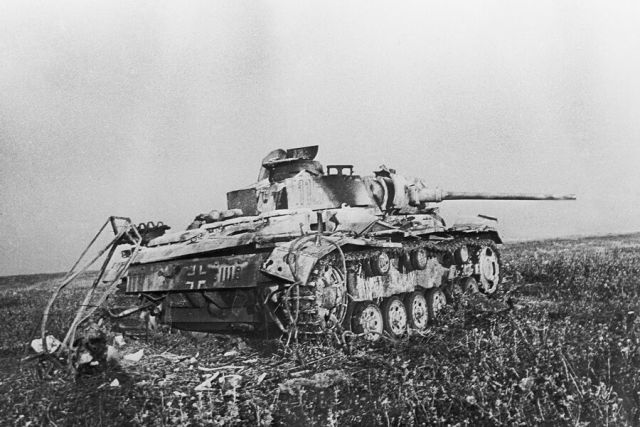
A downed fascist tank near the Prokhorovka station during the Battle of the Kursk Bulge in 1943
Image source: Yakov Ryumkin/RIA Novosti
But not only Soviet tanks played a role in the failure of Operation Citadel. German General Friedrich von Mellentin notes in his memoirs that before Operation Citadel, the Russians "improved the defense in the likely directions of our breakthrough, built several defensive lines and turned tactically important settlements into powerful resistance nodes. The whole area was literally littered with mines...". Agree, this reminds me of something already from today's days.
The High price of Victory
After the tank battles on the Kursk Bulge, the Soviet leadership made all the necessary conclusions. The production of T-70 light tanks has been completed and the production of promising T-80, which were going to replace them, has not been deployed. Upgraded T-34-85 tanks and IS-2 heavy tanks began to arrive to equip armored units and formations of the Red Army, allowing them to successfully fight the new German vehicles.
The production of the T-34-85 started in January 1944 at the Krasnoe Sormovo plant No. 112 in Gorky. By the beginning of the spring of 1944, two other plants, No. 174 in Omsk and No. 183 in Nizhny Tagil, had joined the serial production of the T-34-85. The production of IS-2 heavy tanks with a 122-mm D-25T cannon was launched already in early 1944. For the first time, the tank was used in the Korsun-Shevchenko operation.
A very high price was paid for the victory on the Kursk Bulge by the armored and mechanized troops of the Red Army. 1,614 Soviet tanks and self-propelled guns were lost in the Kursk strategic defensive operation, 2,586 tanks and self-propelled guns were lost in the Orel strategic offensive operation, and 1,864 tanks and self-propelled guns were lost in the Belgorod-Kharkov strategic offensive operation. Total - 6064 tanks and self-propelled artillery units. There are still disputes about the losses of the Wehrmacht in the Battle of Kursk (according to various sources, Germany lost from 760 to 1200 tanks). General Friedrich von Mellenthin, in particular, writes: "Our tank divisions, which were in such excellent condition at the beginning of the battle, were now drained of blood."
Mikhail Khodarenok
